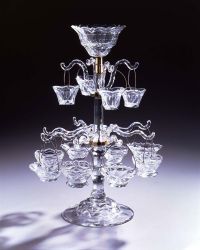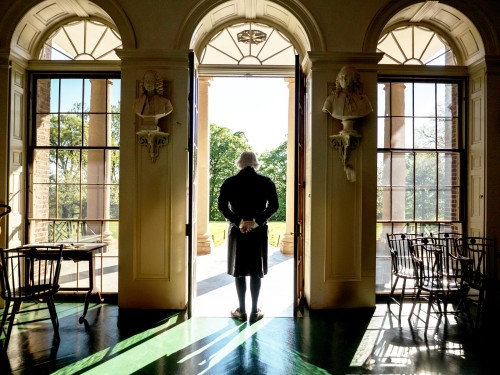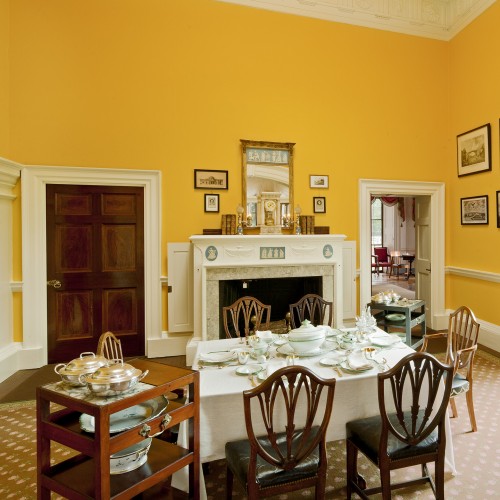Guests to Monticello noted that the first dinner bell customarily rang at three o'clock, and the second called them to the table at four. When they arrived in the Dining Room, they quite likely found Thomas Jefferson reading. Having a self-described "canine appetite for reading" and hating to waste even a moment waiting for others to gather, he kept books on the fireplace mantel.
"Dined at the President's"
 Dinner was the largest of the two meals of the day, though tea was often served later. While no visitors recorded menus of dinners at Monticello, we do have descriptions of meals served at the President's House (now the White House) during Jefferson's terms. Jefferson's presidency was marked by lavish hospitality; in the words of one guest, "Never before had such dinners been given in the President's House."
Dinner was the largest of the two meals of the day, though tea was often served later. While no visitors recorded menus of dinners at Monticello, we do have descriptions of meals served at the President's House (now the White House) during Jefferson's terms. Jefferson's presidency was marked by lavish hospitality; in the words of one guest, "Never before had such dinners been given in the President's House."
Another guest describes a relatively "inelegant" meal: "Dined at the P.'s [President's] -- . . . Dinner not as elegant as when we dined before. Rice soup, round of beef, turkey, mutton, ham, loin of veal, cutlets of mutton or veal, fried eggs, fried beef, a pie called macaroni . . . . Ice cream very good . . .; a dish somewhat like pudding . . . covered with cream sauce -- very fine. Many other jimcracks, a great variety of fruit, plenty of wines, and good." Aside from the food, guests at the President's House during Jefferson's tenure were often surprised (and occasionally offended) by his practice of seating guests in the "pell-mell," or somewhat random, style, rather than according to rank.
 "Half-Virginian, Half-French Style"
"Half-Virginian, Half-French Style"
 Jefferson's culinary preferences were in part formed during his years as Minister to France. Even before his time abroad, Jefferson had arranged for a French chef in Annapolis, Maryland, to train one of his slaves. On learning of his diplomatic appointment, Jefferson decided to bring his slave James Hemings with him to study "the art of cookery."
Jefferson's culinary preferences were in part formed during his years as Minister to France. Even before his time abroad, Jefferson had arranged for a French chef in Annapolis, Maryland, to train one of his slaves. On learning of his diplomatic appointment, Jefferson decided to bring his slave James Hemings with him to study "the art of cookery."
Family recipes that have survived -- eight in Jefferson's own hand -- include blanc mange (almond cream) and nouilly à maccaroni (a pasta dough). Outside of France, Jefferson enjoyed delicacies such as waffles in Holland. On his return to America, many such dishes, including ice cream, were considered novelties. He also imported a variety of foods, such as Italian olive oil and French mustard.
The French influence endured at Jefferson's table for the rest of his life: in 1824, Daniel Webster noted that dinners at Monticello were "served in half Virginian, half French style, in good taste and abundance."
Vines and Wines
 While in France Jefferson cultivated his love of the fine wines of Europe and began a life-long habit of collecting wines -- and vines -- for America. Known throughout the States as a wine connoisseur, Jefferson advised presidents Washington, Adams, Madison, and Monroe on the best wines for executive functions. His cellar contained bottles from France, Portugal, Spain, Hungary, Germany, and Italy, and he served wine after dinner daily in the belief that it was good for the health. More information about Jefferson and wine is available in the "Attending to My Farm" section of "Jefferson."
While in France Jefferson cultivated his love of the fine wines of Europe and began a life-long habit of collecting wines -- and vines -- for America. Known throughout the States as a wine connoisseur, Jefferson advised presidents Washington, Adams, Madison, and Monroe on the best wines for executive functions. His cellar contained bottles from France, Portugal, Spain, Hungary, Germany, and Italy, and he served wine after dinner daily in the belief that it was good for the health. More information about Jefferson and wine is available in the "Attending to My Farm" section of "Jefferson."
"Vegetables. . . Constitute My Principal Diet"
Also for health reasons, Jefferson ate meat only "as a condiment to the vegetables which constitute my principal diet." Many family members remarked on this habit, and though we cannot call Jefferson a vegetarian as defined today, for his time, he did eat an unusually small amount of meat, preferring the produce of his garden. The garden featured more than 250 varieties of herbs and vegetables, including those that others considered exotic or even possibly poisonous, such as the tomato.
Self-Service
Dinner at Monticello was an occasion for lively, lingering conversation, and Jefferson did not want talk to be hindered by the presence of house slaves, who might either interrupt or eavesdrop. Consequently, Jefferson and his guests served themselves with the help of a collection of dumbwaiters, two of which were hidden in the fireplace and were used to bring wine up from the cellar.

